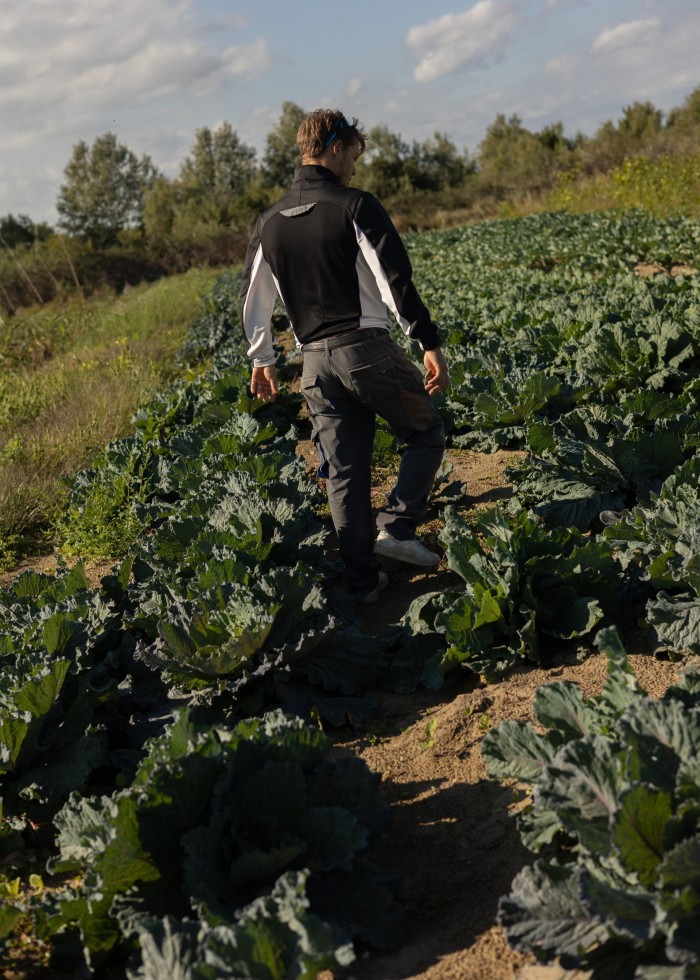This article is part of a new guide to Venice from FT Globetrotter
Some say Venice is in a doom spiral. La Serenissima is sinking into the rising waters of the surrounding Veneto lagoon, her population is in decline, as is her reputation as a dining destination, dragged down by sad spaghetti and pizza served at touristy venues. However, a handful of Venetian restaurant owner-chefs are throwing their home a lifeline and working towards a more sustainable future.
Four years ago, as engineers put into operation a giant barrier to spare Venice from future flooding, these local chefs launched their own rescue plan: a co-operative farm to create jobs and save the unique flavours of the fruits and vegetables used in Venetian dishes that are at risk of disappearing. Together, they leased a four-hectare plot of land on Sant’Erasmo, the rural island known as Venice’s kitchen garden that’s about 40 minutes away from the centro storico by boat. Planting began in 2021 at the shared farm, called Osti in Orto (Hosts in the Garden), which now supplies a dozen top chefs with local varieties of seasonal produce used in Venetian cuisine, including aubergines, root and leaf vegetables, radicchietti (tiny field lettuce), fennel, peppers, tomatoes and herbs.
“Sant’Erasmo vegetables are special — they come ready-seasoned inside,” says chef Francesco Agopyan of Antiche Carampane, a participating trattoria (see below). “The salt in the air and soil close to the lagoon mixes with their natural sugars and gives them a distinctive taste.”


Named after a patron saint of sailors, Sant’Erasmo is a quilt of market gardens, orchards and small farms on soils of clay and sand, the second largest of the lagoon’s 100-plus islands after Venice. Local chefs are worried that Sant’Erasmo’s existential fate is the same as Venice’s. Elderly residents are dying, while their children and grandchildren want an easier life on the mainland, so smallholdings with local delicacies are at risk of disappearing with them.
“But it’s too late to be pessimistic,” says Cesare Benelli, who runs Al Covo restaurant in the Castello district of Venice with his Texan wife, Diane, and whose idea it was to start Osti. “By acting decisively, we can bring Venice out of the coma into which she has sunk.”
Benelli was a boy in the 1950s when the historic centre of Venice was a vibrant community of some 160,000 full-time residents — it recently fell below 50,000 — and he’s seen Sant’Erasmo’s official number decrease by more than 50 per cent over a decade of visits to a mooring he keeps there. He says only 500 people live there year-round.

Remarkably, Osti is managed by a 24-year-old, Mario Saviolo, who grew up on the island. Raised by grandparents who had a farm, Saviolo introduced himself to Benelli and Agopyan when he heard about the project. You couldn’t imagine a better custodian.
On a sweltering July morning when I visit Osti, I find Saviolo harvesting vegetables and looking laid-back in mirror sunglasses. He leads me over an aquifer to a field of ripening squash, pulls a few carrots from the sandy soil, twisting off their feathery tops, and digs a handful of potatoes — yellow, pink, fingerling — telling me which are best for salads or mashing.
“My grandparents were great teachers,” he says. “I learnt how to sow using the lunar cycle, irrigate crops exactly when needed, recognise harmful insects, and use the right tools to work the land.”
Saviolo studied environmental biotechnology in la città (the city), but he’s committed to a farming life on the island despite the risks. Sant’Erasmo suffered a devastating flood in 1966 that wiped out a generation of dairy farms, and it is vulnerable to unpredictable weather and the effects of climate change.
“It’s not easy here,” he says. “It’ll be several years before we’re profitable. You don’t plant and immediately get a sustainable farm. But Sant’Erasmo is a special place, one of the few green oases still cultivated where nature is allowed to spread.”
The investors in Osti have their lease for nine more years. The co-operative plans to add greenhouses in late 2024 and is open to new members. “Se vuole, può unirsi a noi,” Agopyan tells me. Anyone who wants to can join us.
There are many ways to enjoy Sant’Erasmo’s bounty, from visiting Osti in person for an aperitivo and cicchetti (Venetian-style tapas on bread) to dining at the participating restaurants it supplies. Together, like Sant’Erasmo itself, they honour and remind me of the extraordinary culinary richness of la laguna and the sense of connection Venetians feel with it.
Antiche Carampane
San Polo 1911, Rio Terà de le Carampane, 30125 Venice
-
Good for: Challenging friends to find it on a first visit without GPS — at least one of the alleys on approach looks like a dead end
-
Not so good for: Boasting to your friends you’ve found a secret spot
-
FYI: Order the fritto misto. You might think it’s a cliché, but this is a next-level mix of calamari, mysterious local varieties of fish to eat, bones and all, with your fingers, sweet batons of (Sant’Erasmo) carrot and cubes of potato
-
Opening times: Tuesday–Saturday, 12.30pm-2.30pm and 7.30pm–10pm
I first ate here 15 years ago when Francesco Agopyan’s mother, Piera, expertly signora-bossed the cucina, and still recall every giddy bite of fingernail-size fried crab and shrimp served in paper cones before the main course. Agopyan now oversees the kitchen, which turns out playful twists on Venetian classics and top-notch versions of standards, including cuttlefish in its own ink with polenta, liver with onions, and risotto from rice grown in the nearby wetlands of the lagoon.


Agopyan is passionate about saving Venice — maybe it has something to do with Venice having saved his family from extinction two generations ago. His Armenian grandfather escaped to the city from Istanbul in the catastrophe of 1915 and married a Venetian woman.
“Venice needs help,” he says while serving me spaghetti in cassopipa (with seafood in a spiced sauce crowned with a roasted red Sant’Erasmo tomato). “The world needs to know that a different Venice is possible.” A second-generation restaurateur, Agopyan is determined to back Osti in Orto for the long haul: “The co-operative is an investment in Venice, our people, our heritage, our future.”


Carampane, as locals call it, is an old trattoria (reputedly a former canteen serving the customers of a brothel — antiche carampane means “old hags”), so the atmosphere is more relaxed than at a more formal restaurant. No one will judge you if, as I did, you pick a starter of grilled octopus as your main. My meaty tentacle came curled around lobes of crushed yellow potato with Osti cherry tomatoes, parsley and dabs of vegetable emulsion.
Carampane also conjures imaginative takes on local desserts: if you can, leave room for natural-yoghurt gelato or a sgroppino — a refreshing lemon sorbet meets cocktail of vodka topped with nutmeg, lemon zest and black pepper.
Al Covo
Campiello de la Pescaria 3968, 30122 Venice
-
Good for: A mash-up of multi-course tasting menus and US-style chocolate cake
-
Not so good for: Showing up in shorts for a quick pizza
-
FYI: Handy for visitors to Biennale art and architecture events at the nearby Arsenale. You can easily drop by without a reservation at the start of service
-
Opening times: Thursday–Monday, 12.45pm–2pm and 7.30pm–10pm
Cesare Benelli and his American wife, Diane, have been running Al Covo, a cosy two-room restaurant with exposed brick walls in the Castello district of Venice, since 1987. Their son, Lorenzo, has taken over the kitchen, now that his white-haired papa is technically “retired”. But don’t be fooled. You’ll find Benelli inside morning, noon and night, making sure you know he’s still the brains behind a menu rigorously devoted to local provenance.


In warmer seasons, diners might luck out with a grey mullet crudo on the menu from a brackish part of the lagoon, its soft flesh flecked with finely cubed carrots, red pepper, potato and celery from his beloved Osti. Or go for the crudo dell’Alto Adriatico selection of fish and seafood from local waters.
Don’t miss Al Covo’s version of deep-fried fiori di zucca, squash flowers stuffed with burrata — you’ll be surprised by the fresh mint used instead of the usual basil (ask for a single fritter if you can’t manage a full order). Crab lovers should order tagiolini alla granzevola, a thin, spaghetti-length pasta with spider crab, plated with the shell of the crustacean. In spring I’ve enjoyed fat Montina asparagus (indigenous to Sant’Erasmo) with shavings of lemon zest and — yes, always — fritto misto, with polenta on a twirl of string potatoes. Diane’s “Devil’s Food” chocolate cake and US-style desserts, such as her cheesecake with buffalo ricotta and cherry sauce, will delight the sweet-toothed.


Benelli is a life-long chef and businessman but, recently, a quiet activism has stirred his soul. He bemoans a lack of vision by politicians to preserve the community in his home city and its adjacent islands. Osti in Orto is a late-career practical and political act.
“My dream is that the city and islands can return to being a community,” he says. “That Sant’Erasmo and other islands in the lagoon be recognised as a vital part of the city, which would help stimulate and implement a housing plan to bring people back there to live.”
At Al Covo’s bar, he displays glass jars of Sant’Erasmo heritage fennel — snow-white orbs the size of baseballs from last year’s harvest — and a copy of Atlante gastronomico dei Presìdi Slow Food, an atlas of ingredients recognised by the Slow Food foundation for their artisanal value and risk of disappearance, including Sant’Erasmo’s celebrated violet artichokes. “Mario,” he says of the farm’s young custodian, “Is the future.”
Osti in Orto
Via dei Forti 75, 30141 Venice
-
Good for: People eager to dig deeper into life in the lagoon, not just “do” Venice
-
Not so good for: Travellers who don’t like boats or getting muddy
-
FYI: You need to book in advance and take a number 13 vaporetto from Fondamente Nove D boat stop in Venice to Sant’Erasmo-Chiesa (second stop on the island)
-
Tours: April to December


For those curious to see the chefs’ co-operative farm in person, Alvise Cinelli — the manager of Marciano (see below), one of the participating venues — will take visitors on a two-hour tour. It begins with a visit to the fields followed by an aperitivo (maybe a Sant’Erasmo sparkling wine) and cicchetti.

Tours can be booked on the Inside Venice portal, where prices start at €150 for two people, rising to €550 for a group of 10. Alternatively, take the vaporetto and roam on your own to take in the island vibes, or privately rent a bike (RideMovi is the local bike-share app). Don’t worry about getting lost: there’s really only one road around the island.
Other top venues in the co-operative
Osteria alle Testiere, a popular bistro, serves traditional Venetian dishes and fresh seafood and fish caught on the day of service (the menu changes depending on market availability). It’s small — booking ahead is highly recommended. Website; Directions
Riviera, a relaxed waterfront restaurant with a refined menu, serves contemporary takes on Venetian classics. Directions
Vini da Gigio, a family-run trattoria in the Cannaregio district, offers classic local dishes in a rustic setting, with a good selection of wines. Website; Directions
Da Guido, an elegant restaurant on the nearby peninsula of Jesolo, has served refined seafood dishes, fresh pasta and other local specialities since the early 1990s. Visit in warmer seasons and enjoy an aperitivo in the garden. Website; Directions
Marciano, a pub in the Cannaregio district, offers local dishes in a casual environment. It also makes its own IPA and gin with produce from the Venetian islands. Website; Directions
More ways to enjoy Sant’Erasmo’s produce

Shop
I Sapori di Sant’Erasmo (Flavours of Sant’Erasmo) is a 10-hectare family farm — the island’s largest — and a 15-minute walk from the Capannone vaporetto stop and public dock. Brothers Carlo and Claudio Finotello started it in 1996. Ring the bell on the counter and someone will come from the adjoining shed to serve you, then decide which variety of squash or pumpkin to lug away, or go for the excellent products in glass jars: crema di carciofo violetto (cream of violet artichokes), radicchio in saor (radicchio in vinegar with onions), mostarda di zucca (pumpkin conserve). It’s hard to stop. Food lovers across the Veneto region recognise the quality of this farm’s seasonal produce. I have Italian friends in Padua (40km from Venice) who come by motorboat once a week — a day trip with a stop for lunch — to load up on radicchio, squash and jars of preserved foods, while I usually end up checking in an extra bag to fly home with a supply as gifts and to serve at drinks parties.

In Cannaregio, I & S Farm Il Biologica di Sant’Erasmo sells produce and preserves from the organic farm of Ilaria and Savino Cimarosto. Try the cream of aubergine, cream of white onion, apple and ginger jam, pumpkin compote with cardamom or cooked purple beetroot preserved in oil.
Elsewhere in Italy, Rialto Frutta offers nationwide delivery of Sant’Erasmo produce.
Sip:
Gin dei Sospiri, a Venetian distilled gin, is made with Sant’Erasmo botanicals: samphire, basil, thyme, artichoke and cardo (a big thistle, cardoon in English). You can buy litre and half-litre bottles at Maramao, a delicatessen with a wine store and bakery in Cannaregio.
Italian Free Spirit also creates drinks made with local produce. I like the Amaro Venesian, a liqueur made with certified handpicked Sant’Erasmo violet artichokes and herbs. Look out for owner Giacomo Tenconi and his colleagues mixing cocktails at events with live music around Venice.
Have you visited Osti in Orto or dined at one of its restaurants? Tell us about it in the comments below. And follow FT Globetrotter on Instagram at @FTGlobetrotter
Cities with the FT

FT Globetrotter, our insider guides to some of the world’s greatest cities, offers expert advice on eating and drinking, exercise, art and culture — and much more
Find us in Venice, Paris, Rome, London, Tokyo, New York, Frankfurt, Singapore, Hong Kong, Miami, Toronto, Madrid, Melbourne, Copenhagen, Zürich, Milan, Vancouver and Edinburgh











































































































































You must be logged in to post a comment Login